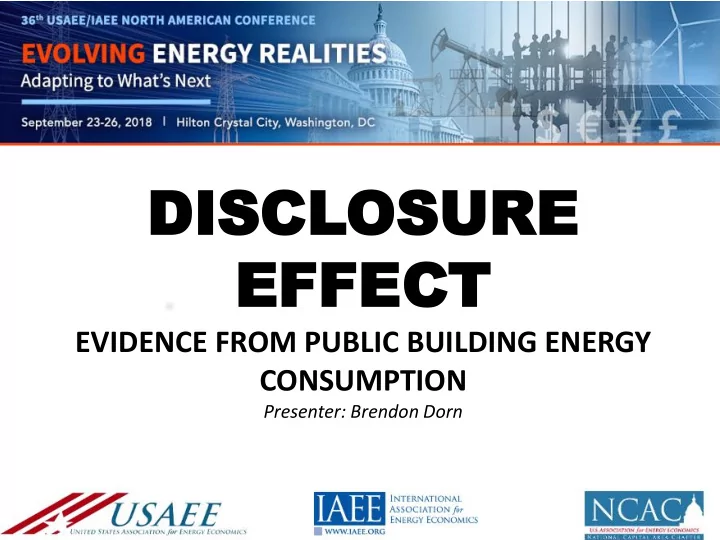

DISCL DISCLOSURE OSURE EFFE EFFECT CT EVIDENCE FROM PUBLIC BUILDING ENERGY CONSUMPTION Presenter: Brendon Dorn
BACK CKGR GROUND OUND (Not excessive)
LANDSCAPE
IDENTIFICATION STRATEGY Measure: Energy Use Intensity (EUI) – Miles per Gallon for buildings EUI = 120
IDENTIFICATION STRATEGY Reported per square foot and per year in common energy unit: kBtu Site EUI: 197 kBtu/sf/year Source EUI: 390 kBtu/sf/year Source: Portfolio Manager Technical Reference, March 2016, CBECS Medical Inpatient
DATA AND A AND EMPIRICAL EMPIRICAL ESTIMA ESTIMATION TION
ANALYSIS INTRODUCTION 1) Economics of Information Disclosure isolated to: i. Market Efficiency ii. Supply and Demand Responses
DATA AND EMPIRICAL ESTIMATION Using building (n=19,988) energy consumption data from cities with mandatory disclosure policies, I estimate the effect of disclosing information to the public absent market motivation
IDENTIFICATION STRATEGY y = mx + b + e where EUI (+) y is energy use (0) x is policy implementation (-) m is the slope (+ ,- , 0) Policy and Public e is error (random) Database
RESUL RESULTS, TS, CONL CONLCL CLUSION USION & & RECOMM RECOMMEND ENDATIONS TIONS
RESULTS Model results suggest between 2%-6% decrease in energy consumption during period after disclosure
Considerations and Conclusions 1) Further robustness checks for model; add EISA observations 2) Reference point is key – minimize adverse effects such as rebound 3) Advocate more cities to adopt benchmarking as mandate or voluntarily i. Experiment with messages to maximize the response to the public disclosure
RECOMMENDATIONS (Policy) 1) Advocate more cities to adopt benchmarking as mandate or voluntarily 2) Experiment with messages to maximize the response to the public disclosure
Recommend
More recommend